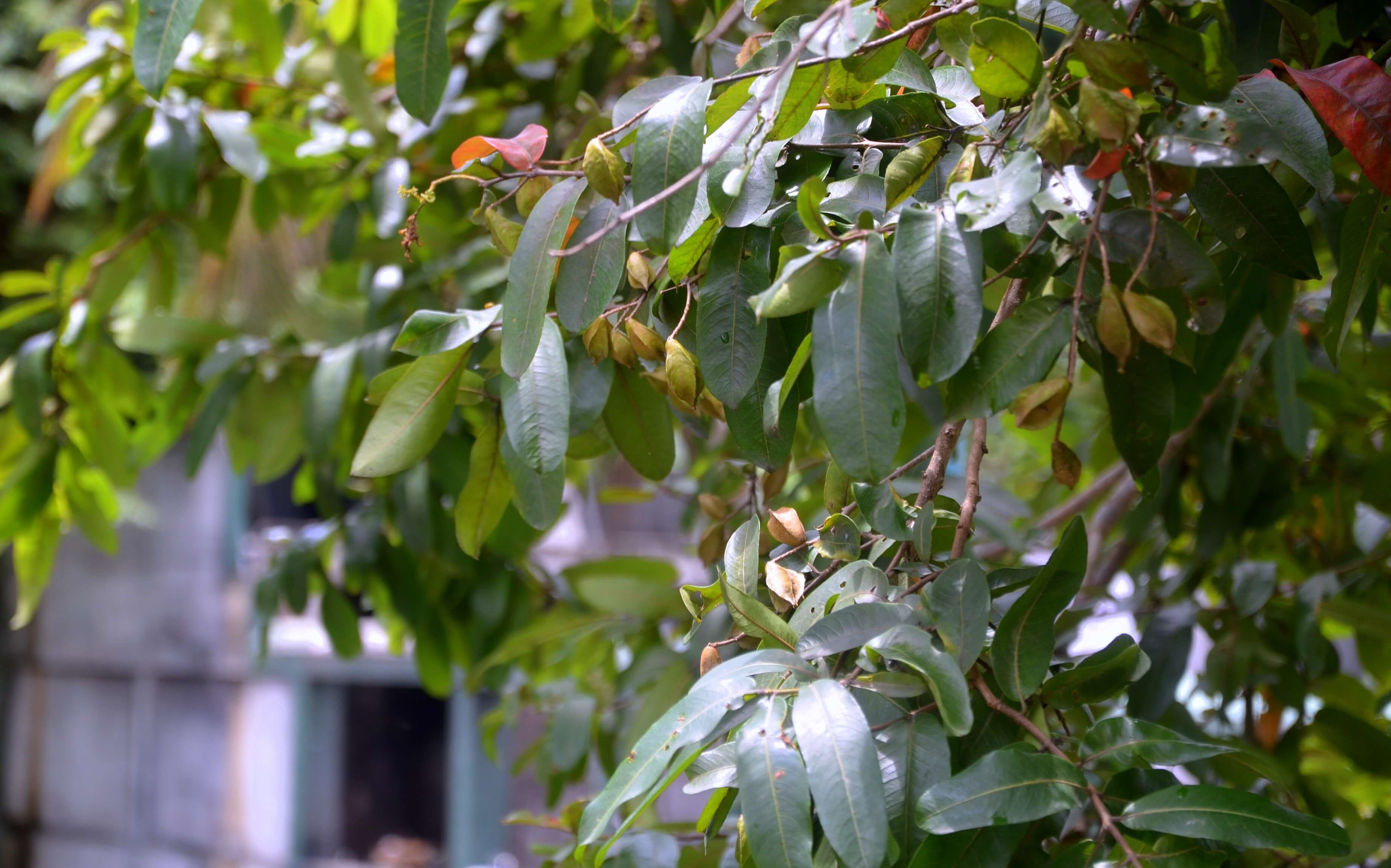
ශාක කුලය - කොම්බිට්රාසියේ - Combretaceae
කුඹුක් ගස දැවැන්ත ගණයට අයත් ගස් වර්ගයක් වන අතර මින් ලබාගන්නා බහුවිධ ප්රයෝජන නිසා වටිනාකම වැඩි වී ඇත. සාමාන්යයෙන් කුඹුක් ගස වැඩෙන්නේ ජලය ආශ්රිතවයි. ඇටුවන් සහිතව වටකුරු විශාල කදින් යුත් කුඹුක් ගසේ වර්ධනය අවසන් වූ පොතු හැවක් මෙන් ගැලවී යයි. මේ නිසා කුඹුක් ගසේ පොත්ත නිතරම අලුත් වේ. මෙහි පත්රයේ අග උල් නොමැති කවාකාර ගතියෙන් යුත් නිසා මීට ටර්මනේලියා යනුවෙන් භාවිතා වන බව සිතිය හැකිය .
පත්රවල නාරටිය හඳුනාගත හැකි අයුරින් වෙන් වෙන්ව පිහිටා ඇත. අතු රිකිල්ලක දෙපසට බෙදුණ පත්ර කීපයක් එකට ළංව පිහිටා ඇත. කුඹුක් ගෙඩිය දාර තුනක් සහිතව හටගන්නා අතර පැසී වේලී ගිය විට එම දාර පැළී බීජ ඉවත් වේ. මෙම බීජ තෙතමනය ඇති තැනක පතිත වූ පසු එය මාස එකහමාරක් වැනි කාලයක් තුළ අංකුර ඇදී පැළ වේ. කුඹුක් කොළ සහ පොතු වටිනා බෙහෙත් ඖෂධයකි.
කුඹුක් ගස බෞද්ධ සාහිත්යයේ වැදගත් තැනක් හිමි ශාකයකි. ඊට හේතුව වන්නේ අනෝමදස්සී සහ පියදස්සී යන බුදුවරයන් වහන්සේලා ඊට පිටදී බුද්ධත්වය ලැබීම යි. කුඹුක් ශාකය ජලය ආශ්රිතව හොඳින් වැඩෙන නිසා ඇළ,දොළ,ගංගා ආශ්රිතව වැඩියෙන් දැකිය හැකිය.කුඹුක්කන් ඔය ඊට ඉතා හොඳ නිදසුනකි.අති දැවැන්ත කුඹුක් ශාක ගංගා අසබඩ දක්නට ලැබේ.
වියළි කලාපයේ වැව් ආශ්රිතව කුඹුක් ගස දැක ගැනීමට පුළුවන. කුඹුක් ශාකයට කොළ වාරයක් නැත. හැමදාම දළු දමා වැඩේ. පේර ගසේ කොළයට හා පොත්තට සමාන කුඹුක් ගස මැයි මාසයේ පමණ මල් හටගනී. මල් රෑනක් ලෙසින් එල්ලී තිබෙනු දක්නට හැකිය. මල් රෑන පොකුරක් මෙන් පිපුණත් ඉන් ගෙඩි හටගන්නේ ඉතාමත් අඩුවෙන්ය. ගෙඩිය දාර සහිත ය. කුඹුක් ගෙඩි ඉදි පැසී වැටුණ පසු ජලය හා මුසු වී තද කහට ඇති වී කළු පාට හැරේ. එසේම කුඹුක් ගෙඩිය ජලයේ පාවී යාමට හැකි සැහැල්ලු ගතියක් ඇත. ඒ නිසා ව්යාප්තිය ජලය මගින් සිදුවේ. කුඹුක් ඇට රෝපණය මඟින් බෝ කර ගන්නා අතරම ඇළ,දොළ,ගංගා ආදියේ ජලපහරට අසුව ගොස් ස්වයං රෝපණය මගින් තම ශාක බෝ කර ගැනීමේ ක්රමයක් ද පවතී.
ප්රයෝජන -
කුඹුක් ශාකය ඖෂධීය ගුණ දෙන ශාක ගණයට අයත් වන්නේ ඉන් හිස පිරිසිදු කිරීම සඳහා යොදා ගන්නා ටොනික් විශේෂයක් සැකසීම මගින් ය. කුඹුක් දලූ ඉස්ම හිසට ඉතා යෝග්ය බව පවසන අතර ඉස්හොරි සඳහා කුඹුක් කොළ ඉස්ම යෙදීම සුදුසුය.
කුඹුක් අතීසාර රෝග, හෘද රෝග ආදියටද ඔසුවක් ලෙස භාවිතයට ගනී. එසේම කුඹුක් පොත්තේ විෂනාශක ගතියක් අඩංගුව ඇත. දේශීය චිකිත්සාවේදී පැන් නවයක් ගැන සදහන් වේ.ඉන් එකක් කුඹුක්ගැටේ රැඳී ඇති ජලයයි.බොහෝ විශාල කුඹුක් ගස් වල මේ ගැට දක්නට ලැබේ.
කුඹුක් ගසේ නමින් ගම්වලට නම් තබා ඇත. කුඹුක, කුඹුක්ගැටේ, බරවකුඹුක, කුඹුක්මඩිත්ත, කුඹුක්වැව ඊට උදාහරණ වේ.
Type of Genus- Combretaceae
Kumbuk tree is a huge species of tree and its value has increased due to its multiple benefits. Kumbuk
trees usually grow on water. The Kumbuk tree, with its large, rounded stems with stems, loses its
growth like a finished bark. Due to this, the bark of the Kumbuk tree is always fresh. It is thought to be
belonging to the Terminalia family because of the circular shape of the leaf without the tip.
The veins of the leaves are distinctly identifiable. Several leaflets on either side of a twig are close
together. The kumbuk fruit has three edges and when ripe, the cracked seeds are removed. Once the
seeds have landed in a moist place, they germinate in about a month and a half. Kumbuk leaves and
bark have valuable medicinal properties.
The Kumbuk tree is an important plant in Buddhist literature. The reason for this is that the Buddhas
Anomadassi and Piyadassi attained enlightenment under the shade of Kumbuk trees. Kumbuk plant
grows well in water bodies and can be seen in streams and rivers. Kumbukkan Oya is a good example
of this. Huge Kumbuk plants can be found lining the riverbanks.
The Kumbuk tree can also be seen near lakes in the dry zone. Kumbuk has no leaves. It grows leaves
every day. Kumbuk tree, similar to the leaves and bark of the avocado tree, flowers around May. It can
be seen hanging like a bunch of flowers. It blooms like a cluster of flowers but rarely produces fruit.
The nut is edged. When the kumbuk fruit ripens, it mixes with water and becomes bitter and turns
black. Also, kumbuk has a light texture that can float in water. So the distribution is done by water.
While Kumbuk seeds are propagated by planting, there is also a method of autonomous propagation by
floating in the water in streams, rivers, etc.
Kumbuk belongs to the genus of medicinal plants that form a tonic for cleansing the scalp. Kumbuk
leaf juice is said to be very suitable for the head and it is advisable to apply kumbuk leaf juice for
eczema.
Kumbuk is also used as a remedy for diarrhea and heart disease. Kumbuk bark also has a detoxifying
effect. Indigenous medicine refers to nine pans, one of which is the water that stays in the kumbuk tree.
This knot is found in many large kumbuk trees.
The villages are named after the Kumbuk tree. Examples are Kumbuka, Kumbukgate,
Barawakumbuka, Kumbukmaditta and Kumbukwewa.